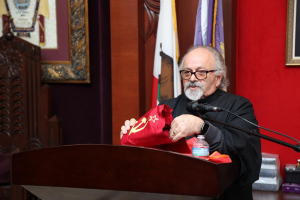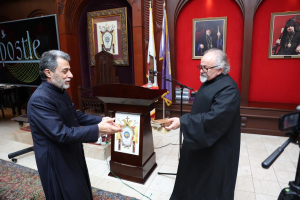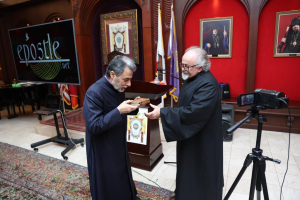Keynote in Nebraska
Armodoxy for Today: Keynote
This is part 2 of a four-part miniseries about the shoot-down over Sasnashen and what it means today.
The day arrived. In the middle of Nebraska, this Armenian priest was to meet with service men from throughout the United States. They had all come to commemorate, remember, and reconnect with a story. They had come to reconnect with others who shared the same values and understanding of the sacrifice made by these 17 men, shot down over Sasnashen, Armenia on September 2, 1958.
The acting President of the Prop Wash Gang, Chief Lonnie Henderson, emceed the program. He had set up a “Missing Man Table” at the center of the banquet hall. The table was set on a white tablecloth, containing 17 red roses in vases and a place setting for one – one representing them all. A shaker of salt next to the setting was a bitter reminder of what had transpired. There, the names of the 17 men were written along with the poem “We See the Eagles Fly.”
Tom Giroir, offered the invocation and introduced me as an Armenian priest. In referencing to my background he pointed to our ministry of “In His Shoes,” that is, those who have suffered evil have a unique responsibility to take action against injustice to others. It was on this premise that I shared my thoughts for the evening with the group.
That day I spoke of the rich story of the Armenian people and the land. I spoke of the Armenian Genocide as an event but also as a springboard to addressing the despicable reality of Genocide that continues to take place in our world. Most especially, I shared with the group the need to stay ever vigilant in their resolve to remember the sacrifices of their fallen brothers. Vigilance and remembrance must have manifestations today in our actions to combat evil on all fronts.
After I offered the ancient requiem prayer of the Armenian Church and remembered all 17 of the fallen servicemen by name, Chief Lonnie honored me in a manner I will forever remember. On behalf of the Prop Wash Gang he presented a shadow box with an actual piece of the downed-plane. Here I would have a tangible reminder of the sacrifice made by these men and the ever-essential necessity to stay vigilant against injustice. He also gifted me Larry Tart’s book, “The Price of Vigilance” signed by the author.
I confessed that in all my travels to Armenia I had never been to Sasnashen. And now, I promised that I can’t think going back to Armenia without visiting Sasnashen. There, I promised the group, I will take the spirit and the energy that was brewing in this room on September 2, 2018. It was a powerful and moving spirit. Since that day, I have shared the story of Sasnashen with countless people through sermons, lectures and videos.
This evening we connected on a human level. We were there to honor sacrifice – the expression of love by these 17 men. We connected Bellevue, Nebraska mystically to Sasnashen, Armenia. This evening we understood that the most fundamental of all human expressions – to extend ourselves to others, to love and share is essential. It is the legacy that has been left to us by the 17 men who were shot down giving themselves for something greater than themselves, for our country and ultimately for humanity. And we accept the challenge to perpetuate and share this legacy beyond this evening.
With the recitation of the poem, “We See the Eagles” the Commemoration on the 60th Anniversary of the Shoot Down came to an end.
WE SEE THE EAGLES FLY
We see the eagles fly…
lookin’ north
toward the Caucasus Mountains
‘bout nine in the morning
Warm September day
Clear
No clouds
We see the eagles fly…
…effortlessly
riding the currents
Soaring above all
Majestic
Supreme
We see the eagles fly…
…and those eagles
look a lot like
The Prop Wash Gang
(September 2, 1997)





